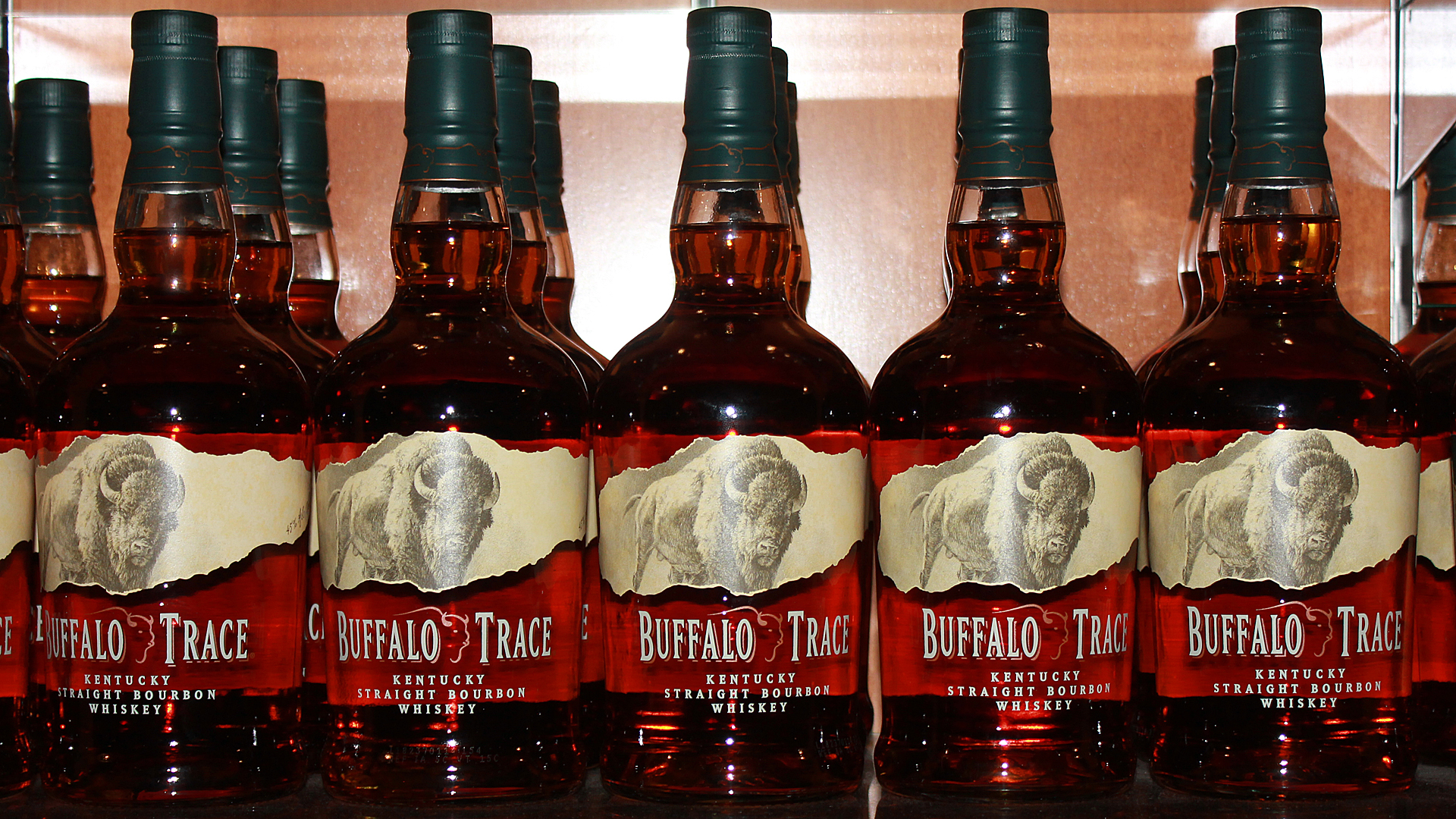
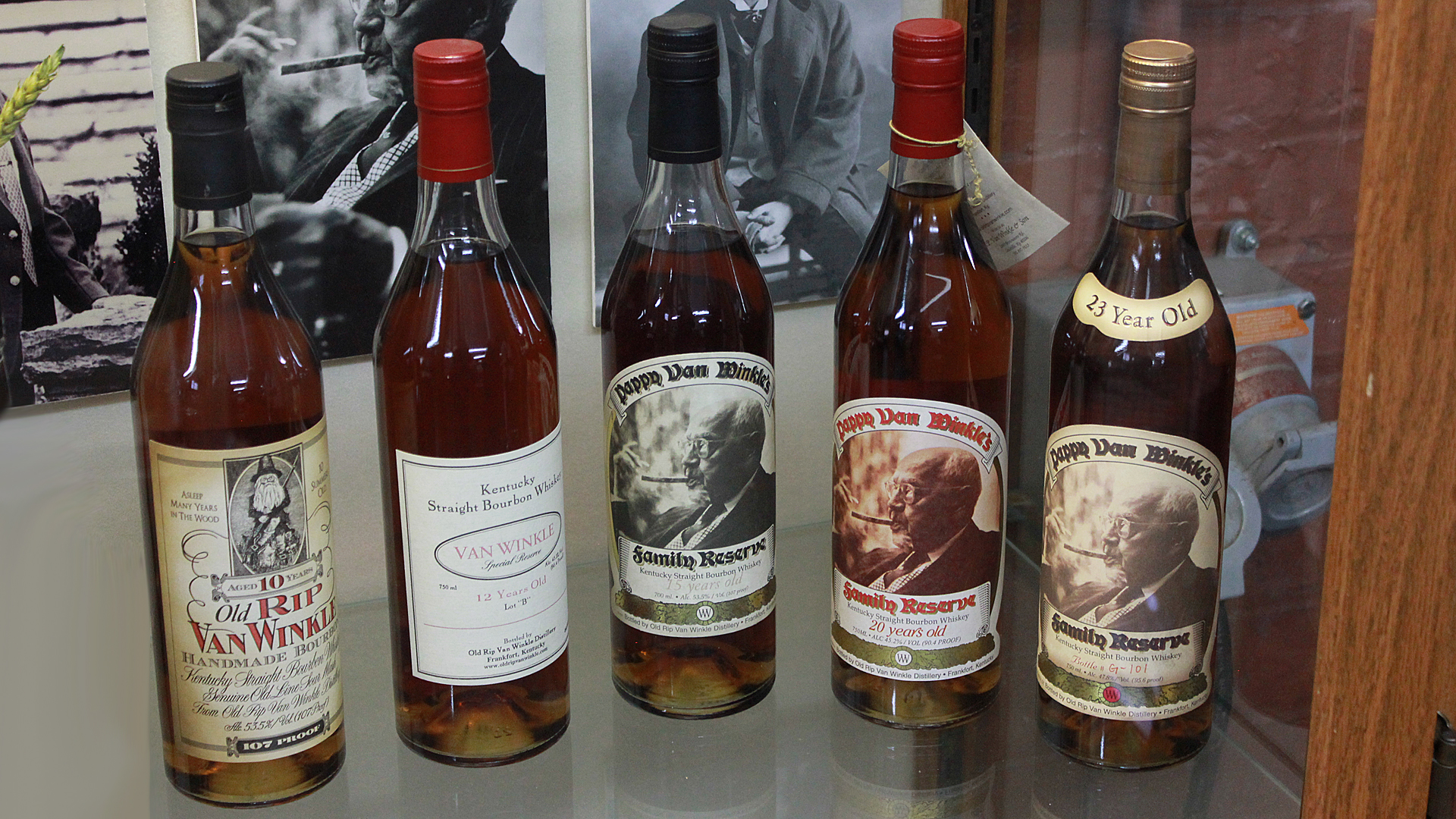
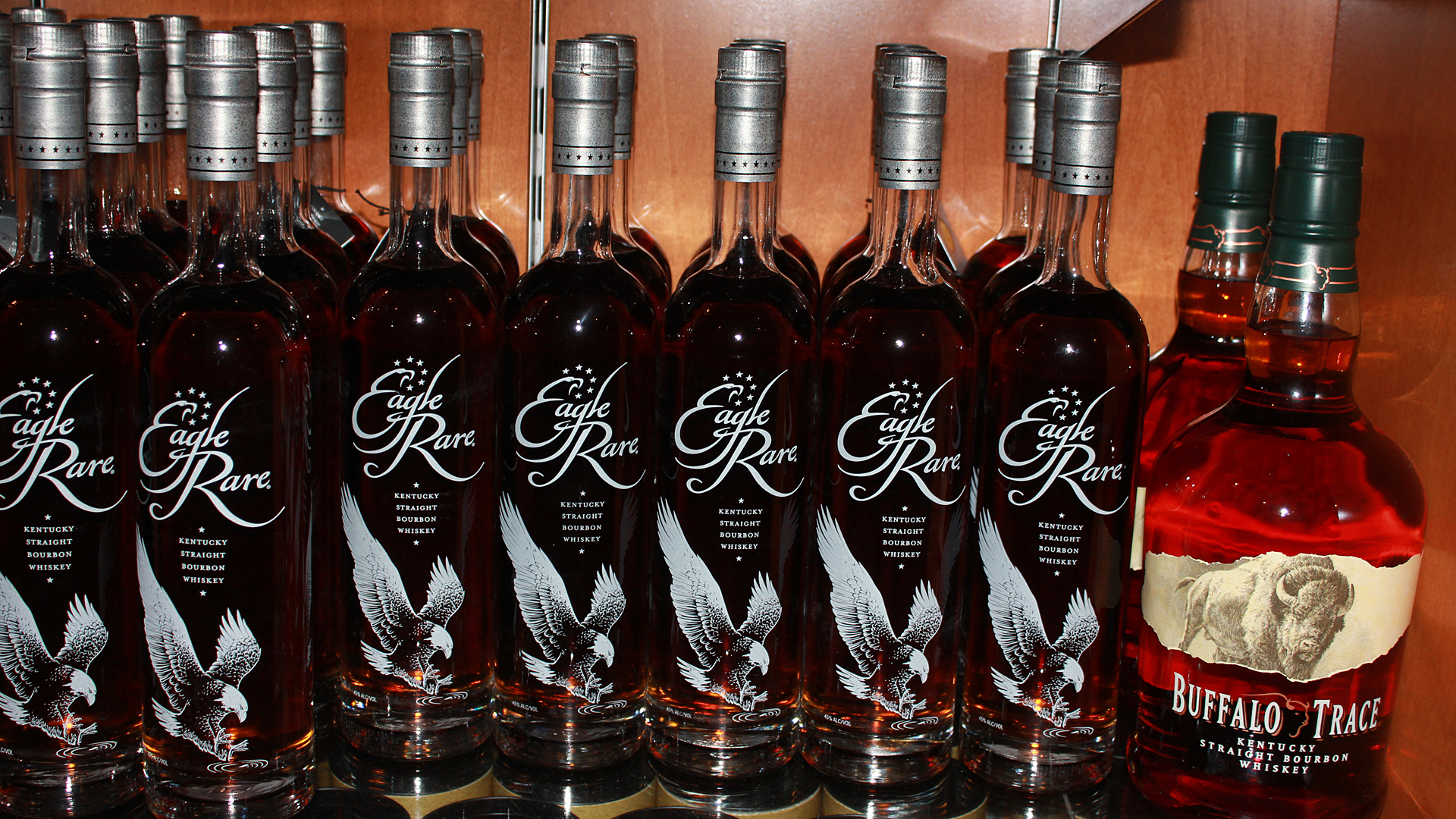
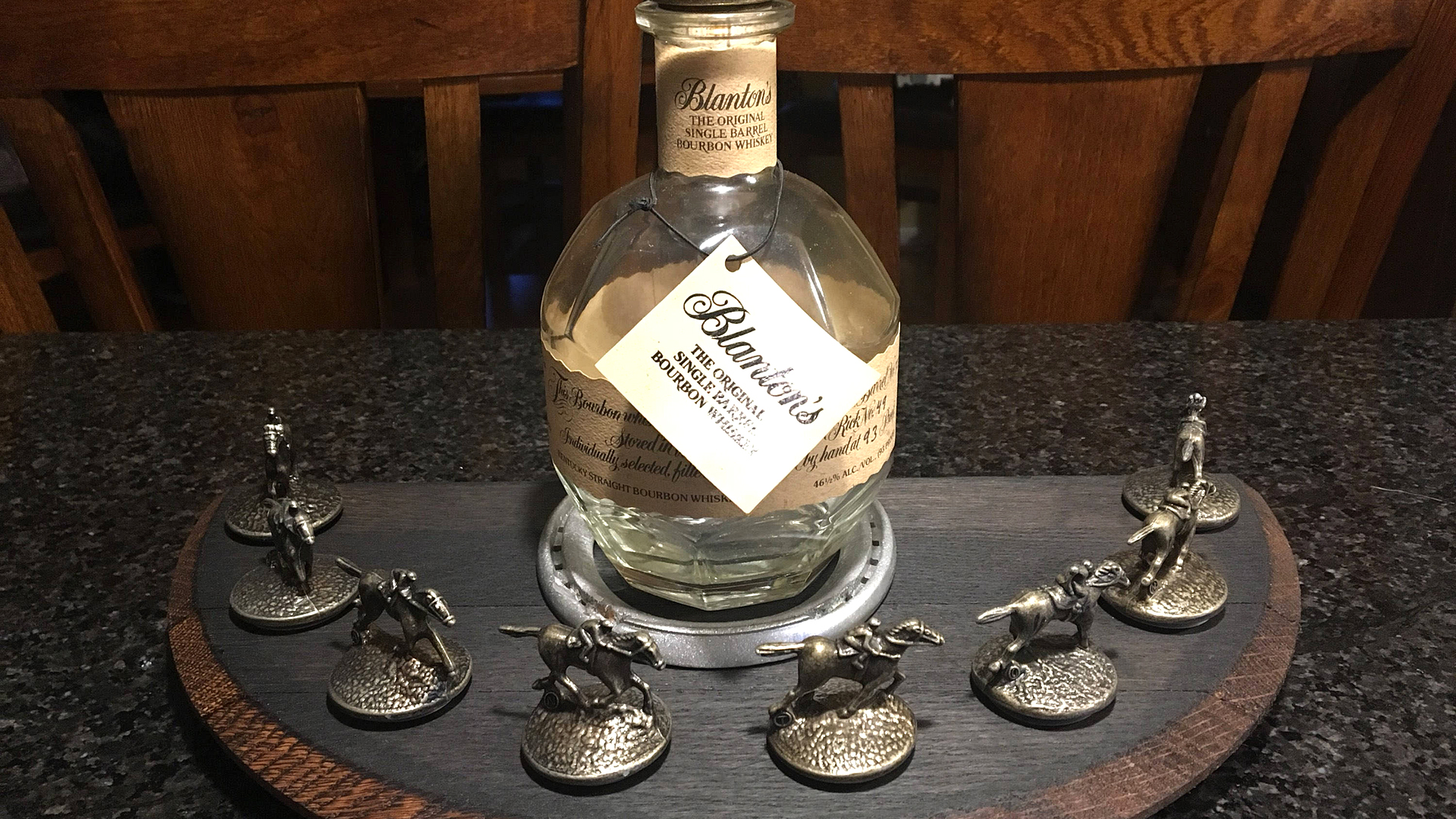
The tour guides we had were excellent. So what did we learn?
The main grains in bourbon are corn, rye, malted barley, and soft red winter wheat. The percentages of each vary by recipe (Mash Bill). Each distillery has its own recipe for the grain mixture. The law requires a Kentucky straight bourbon whiskey to have a corn content of at least 51%. However, the corn content is usually higher (between 60% and 80%).
Traditional Bourbon Recipes are made up of 70 to 80% corn with the balance being rye, barley, and/or soft red winter wheat. Think of sweet and spicy, back of the tongue experience. Bourbon can be up to 100% corn, but corn becomes neutral during aging only keeping the sweetness, so a flavoring grain of rye, barley, and/or wheat are used, and of course the yeast for converting those starches into sugar.
High Rye Bourbon Recipe have up to 18% rye, keeping basically the same amount of barley as a Traditional Bourbon, but doubles up on the rye. Rye is a back of the tongue experience, and gives it that nice white pepper spice like a slice of rye bread. These bourbons will be less sweet and more spicy.
Wheat Bourbon Recipe has 70 to 80% corn which is similar to Traditional, but replace the rye with wheat. Wheat allows the sweetness of the corn, and the sugars from the barrel to be more pronounced. Think milder, smoother and sweet on the front of the tongue.
The different grain types are ground separately and stored temporarily. In former times hammer mills were used until it was found out that they heat up the grain too much, which affects the taste. Today the grain is usually crushed or rolled to expose the starches of the grain. Grains consist mostly of starch, but also of small quantities of proteins, fats and trace elements.
| Distillery | Corn | Rye | Malted Barley | Wheat | Special |
|---|---|---|---|---|---|
| Jim Beam | 77 | 13 | 10 | Different Brands have different Mashbills | |
| Maker's Mark | 70 | 14 | 16 | ||
| Buffalo Trace | 80 | 10 | 10 | Different Brands have different Mashbills | |
| Woodford Reserve | 72 | 18 | 10 |
Alcoholic Fermentation
First the mash has to be cooked. For corn, rye and barley a different solution is needed. These corn types are usually cooked for about half an hour. Some distilleries cook with slight overpressure and at higher temperatures in order to reduce the cooking time to approximately 25 minutes.
| Type of grain | Temperature | Cooking Time |
|---|---|---|
| Corn | 220 degrees F (114 degrees C) | Long with pressure |
| Rye | 170 degrees F (77 degrees C) | Medium |
| Barley | 150 degrees F (66 degrees C) | Short |
After the mash has been cooled down to approximately 77 to 86 degrees F (25 to 30 degrees C), it can be put into a fermenter along with a larger amount of yeast. Each distillery in Kentucky and Tennessee has their own yeast strains, which have survived prohibition from 1919 to 1933 in cooled rooms. The yeast strains are so much kept as a secret that the companies have filed patents for their isolated yeasts, which is possible in the United States. The pH of the solution must be between 5.4 and 5.8 for yeast reproduction, depending on the yeast.
In addition to the yeast part of the stillage is added. The stillage is formed at a later stage. It is part of the much praised sour mash process. Today all American distilleries use the sour mash process. Sour mash means that a part of the distillation residues (stillage) is added to the mash again. After the mash has been prepared with fresh spring water it is chemically neutral, which means the chemical environment is neither acidic nor alkaline. Chemically, this property is measured with pH.
A solution with a pH of 7 is neutral. An acid has a pH smaller than 7. Strong acids have a pH of 3 to 4. If the pH of a solution is higher than 7, it is alkaline. Strong alkaline solutions have a pH of 10 to 11.
After the addition of neutral water, the mash has a pH of approximately 7 (neutral) in which the yeasts can't work properly. The addition of a part of the very sour stillage (pH 5.0 - 5.4) leads to an acidification of the entire mash. After the stillage has been added, the mash has a pH of about 5.4 to 5.8, which is ideally acidic for the yeasts to work properly.
Fresh spring water is needed for whiskey production so the starch in the grain can be cooked and the developing sugar extracted. Distilleries were therefore built near springs that yielded enough water.
Kentucky and Tennessee are located on a large limestone layer that filter out the iron in the water. In valleys where the limestone layer is broken, you can find springs that carry clear water ideal for whisky production.
The length of fermentation varies from distillery to distillery. During alcoholic fermentation yeasts convert the sugar into alcohol and carbon dioxide while also generating heat. Fermentation usually takes 48 to 96 hours to finish and the mash produced a beer with an alcohol content of approximately 8 to 9.5 percent alcohol by volume. The result is called beer or distiller's beer.
Some distilleries evaluate the result of the fermentation. The smell of the beer tells a lot about the future whiskey. The beer is desired to be aromatic (e.g. having a strong apple aroma). A decrease in the aroma of the beer indicates that the yeast is contaminated, and a new yeast strain is used for the next batch.
The size of the fermenters varies between 'large' and 'giant'. Since column stills work continuously and can process large amounts of beer, a steady supply must be guaranteed so they don't run dry. The larger a fermenter, the hotter it gets, since the surface-to-volume ratio decreases with increasing size and the fermenter can't discharge the heat anymore. If the temperature in the fermenter rises above 95 to 104 degrees F (35 to 40 degrees C), the yeasts start dying off until fermentation stops. That's why many fermenters are water-cooled.
That's why American distilleries have a 'beer well' into which the fermented content (beer) is emptied. The beer well is usually made of stainless steel and is placed amidst the numerous fermenters. The size of the beer well corresponds to the size of the fermenters. The beer well is usually one third larger than the largest fermenter, so the column stills can continue production even if the emptying of a fermenter is delayed.
Many American distilleries use column stills for distillation. They were invented by Robert Stein (Haig Co.) in Scotland in 1826 and their pillar-like shape makes a continuous distillation process possible. The basic operation principle is simple: You set up an upright pipe with a height of 16 feet to 65 feet and a diameter of 28 inches to 59 inches. You insert floors with holes into the pipe so there is a connection from the bottom to the top. The edges of the holes are slightly bent upwards so no liquids can flow down through them. Then you insert small tubes so the liquid that accumulates on the floors can flow down to the next floor.
The column is filled with beer in a middle position and heated from the lower end. Thus two opposite flows are created. The liquid distiller beer runs down through the tubes, while the gaseous particles (alcohol vapors) flow upwards through the holes.
The temperature of the column is regulated in such a way that the alcohol is gaseous at the top (172 to 185 degrees F) or (78 to 85 degrees C) and the beer is cooking at the bottom (202 to 212 degrees F) or (95 to 100 degrees C).
This process can run forever as long as there's enough supply of new beer. While the alcohol is extracted at the top, the water with the fibers and remnants of the grain accumulates at the bottom. This product is called 'stillage' and is processed into animal feed and 'sour mash', which is reintroduced into the fermentation process.
In small column stills an alcohol content of approximately 120 American Proof (60 percent alcohol by volume) can be reached at the top. If the columns are taller the alcohol content can be raised up to 160 American Proof (80 percent alcohol by volume) and more.
After the alcohol has been extracted from the still, the steam is led through the doubler, a copper pot, where a catalytic conversion takes place which improves the taste of the whiskey. Many column stills need such a doubler since the column floors aren't made of copper. In copper pot stills, as can be found in Scotland, a continuous catalytic conversion takes place. With column stills that lack copper parts, the distillate must be brought into contact with copper externally. That's what the doublers are for.
The vapor is then led into the condenser where it liquefies again and has now become raw whiskey, which the Americans call 'white dog'. The 'white dog' is regularly tasted directly after production;, it is diluted to approximately 20 percent alcohol by volume. In this state the aromatic substances can be judged best.
After fermentation, the beer is distilled into raw whisky ('white dog'). The spirit safe at Buffalo Trace has two copper barrels shaped liked kegs with windows showing 'white dog' distillate gushing through them, straight from the stills. Each copper barrel is topped with a buffalo, and off to the side the beer tap is topped with a buffalo (that allows the tour guide to fill a glass with fresh distillate).
From the condenser the whiskey is led through a spirit safe into vats, from which either the barrels are filled or trucks are loaded for transport.
From one bushel of grain about five gallons (35.24 liters) of 100 Proof Spirit are produced (2.5 gallons of pure alcohol). Translated to the weight of the grain, approximately 105 to 119 gallons of pure alcohol can be produced from one ton of grain.
Animal Feed
At the bottom of the column stills the so-called setback accumulates. It consists of water, proteins, fats and the fibers of the mash, while lighter materials such as alcohol and esters are extracted over the head of the column still. This aqueous solution from the bottom is pumped out of the container below the column still from time to time.
First the fibers of the stillage are collected by filters. The remaining liquid is dried in large drums using hot steam. The solid parts that accumulate at the drum walls are then mechanically extracted and given to farmers as animal feed. The feed contains a lot of proteins, fats and trace elements.
In Kentucky and Missouri companies specialize in the production of barrels from American white oak. The barrels may only be used once for straight bourbon whiskey. They hold approximately 53 American gallons.
Parts of a Barrel
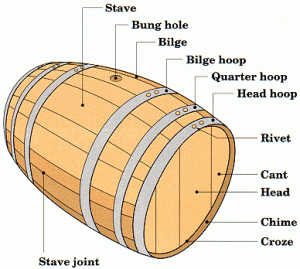
Toasting
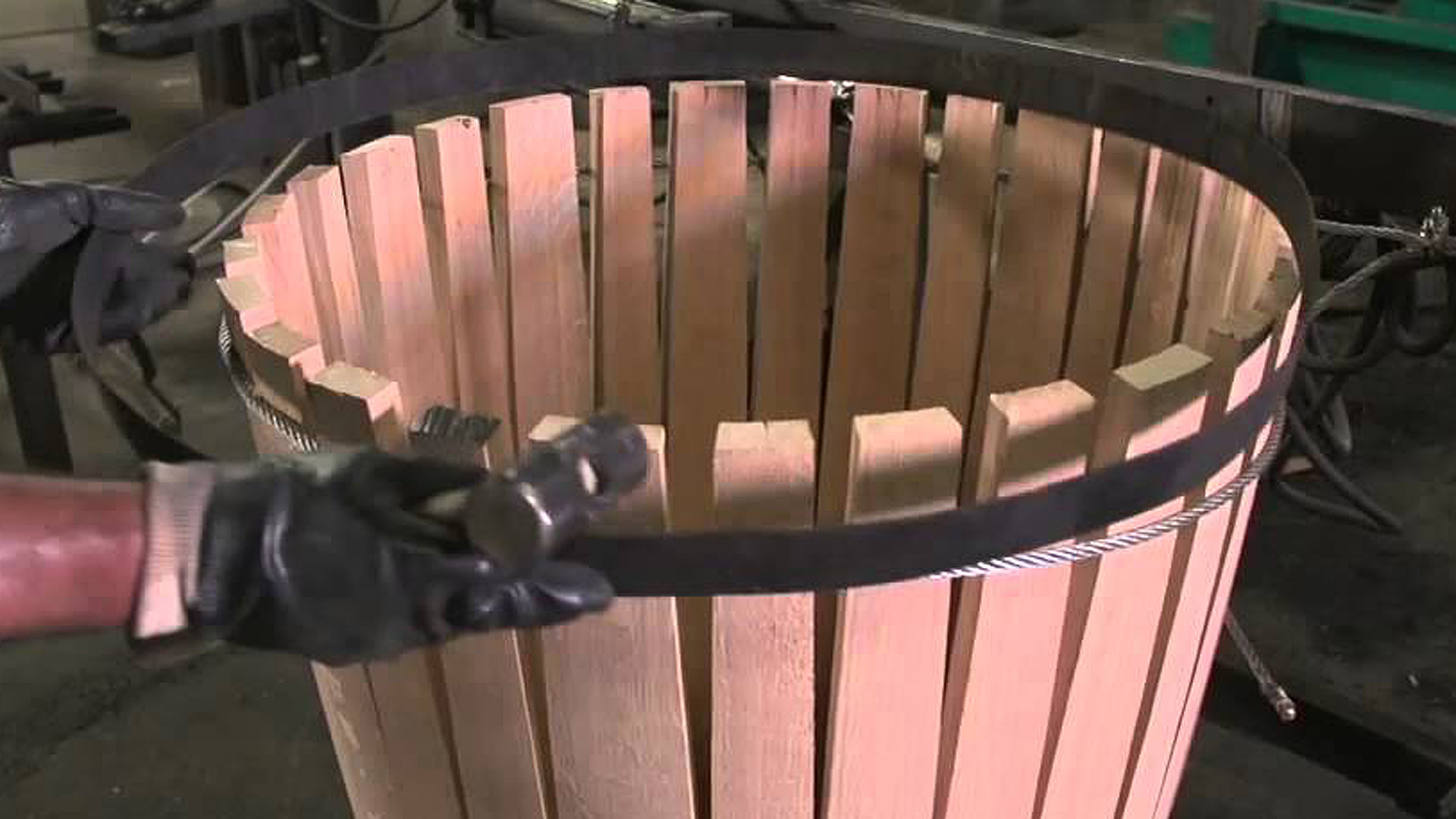
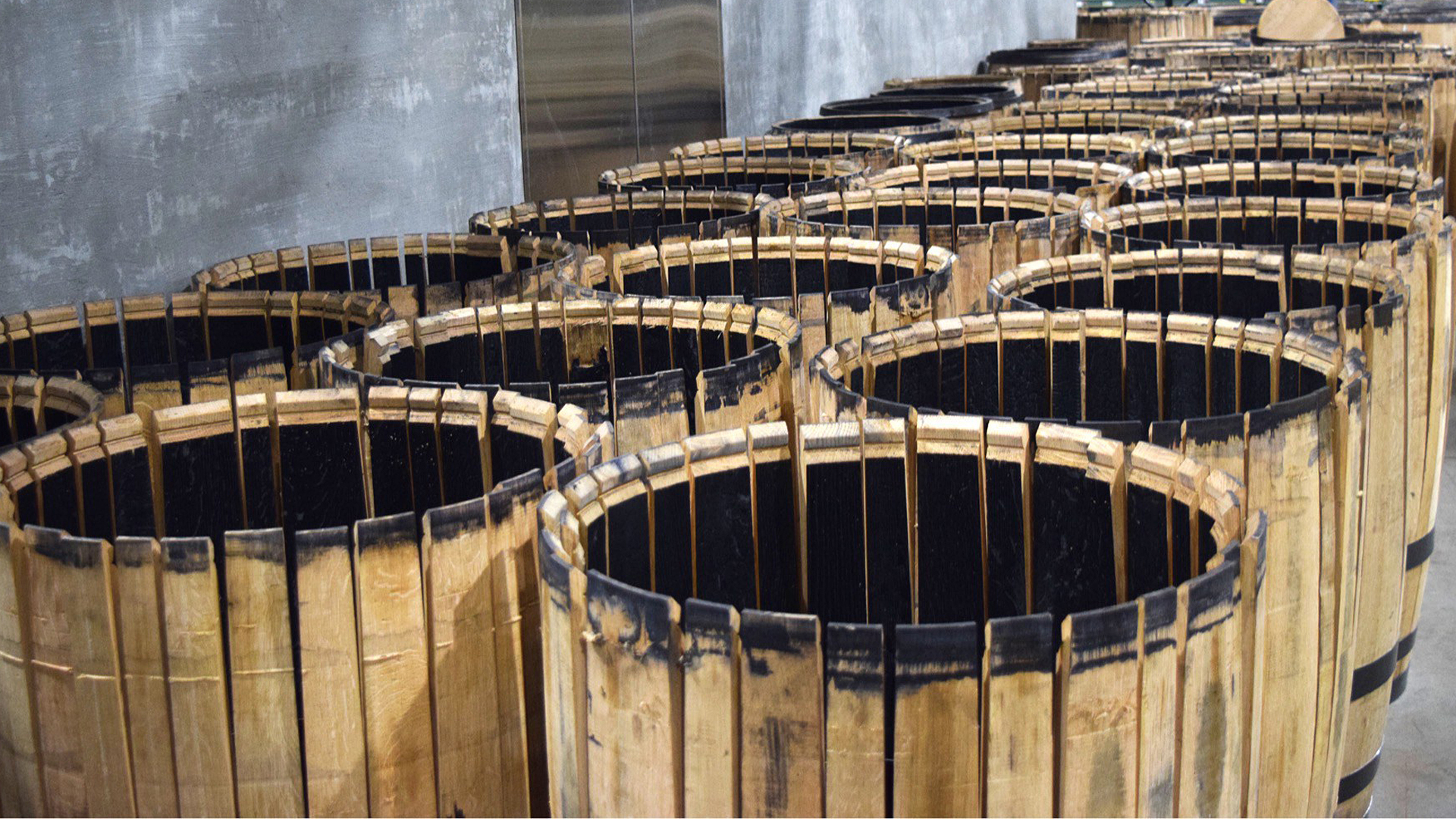 The newly shaped barrel are put through an oven (at 400-600 degrees) for toasting. It takes approximately 12 minutes for light toasting and 40 minutes to obtain a medium light toasting. Toasting crystalizes natural sugars in the wood, releasing aromas of freshly baked bread and roasted marshmallows. The freshly toasted barrels go through another round of quality control after which the barrel is capped with round barrel heads.
The newly shaped barrel are put through an oven (at 400-600 degrees) for toasting. It takes approximately 12 minutes for light toasting and 40 minutes to obtain a medium light toasting. Toasting crystalizes natural sugars in the wood, releasing aromas of freshly baked bread and roasted marshmallows. The freshly toasted barrels go through another round of quality control after which the barrel is capped with round barrel heads.
The next step is special and lends Kentucky straight bourbon its unique taste. The barrels, still open on one side, are held over a small fire. This process is called toasting and makes the wood sugar in the staves on the inside caramelize up to a certain layer. This red layer is later clearly visible when a barrel is disassembled. Toasting takes about 12 minutes.
Bending
The staves of the barrels are first joined but not yet completely closed. Then the staves are made flexible using hot steam and can thus be bent into their oval shape.
To bend the staves into the barrel shape without cracking the wood, each barrel is warmed over an open fire. Once the outside of the barrel reaches 300 degrees F, temporary hoops are placed on the barrel by a hydraulic machine to force the barrel into shape.
Charring
After toasting the barrel is submitted to an even stronger fire treatment. It is burned on the inside with an intense flame for 15 to 55 seconds, which produces a charcoal layer.
Levels of char vary depending on the barrel producer or distillery, but the most commonly used are Level 1 to 4.
Level #1 Char takes 15 seconds
Level #2 Char takes 30 seconds
Level #3 Char takes 35 seconds
Level #4 Char takes 55 seconds (this is also referred to as "alligator char," as it produces a wood texture similar to an alligator's hide)
Carbon is commonly used for filtration. When your barrel is essentially lined with carbon from the charring process, you're able to filter out unwanted compounds, like sulfur compounds found in a young whiskey. The bonus of the alligator char: those deep fissures also allow the spirit to seep back and forth into the interior of the wood, creating more reaction with the uncharred oak. (Char layers tend to be between 1/8 to 1/4" thick.)
Importance of Charring
For bourbon production only new barrels are used. So why char the interior? You might reasonably think that it could add a natural smokiness to the bourbon, but that's not the case at all. Charring the wood actually primes the wood, which impacts the spirit's flavor in several important ways that have nothing to do with smokiness.
Aging in a charred oak barrel is one of the legal requirements for bourbon. Charring is done to change the nature of the oak itself, to yield the best possible reaction between wood and whiskey. While it is the ingredients that give each whiskey brand its distinctive flavor, the wood plays a role, as well, absorbing some of the aging liquid and adding its own "oak" taste. The wood also gives brown liquors their color--the whiskey is actually clear when it goes into the barrels.
First off, charring essentially opens the wood up, making it easier for bourbon to extract flavors. It also catalyzes key chemical changes that are essential to bourbon. Ever tasted vanilla? That's because lignin, the source of vanillin (There are six different types of vanillas you get from a barrel), produces a higher level of flavor the longer a barrel is charred. Likewise, toffee and caramel notes come from hemicellulose, which breaks down into wood sugars in the presence of intense heat. The resting bourbon absorbs these sugars from the barrel interior's caramelized surface as it ages. The results are usually delicious.
It takes a good six years to get bold vanillas out of a barrel. So younger bourbons will not have pronounced vanillas. It takes six years to get the pronounced vanillas in bourbon. Other notes from the barrel include maple, caramel, ginger, clove, toffee, cinnamon, fruits and toasted nuts.
A higher level of char has other effects as well. Higher charred barrels allow less interaction between the wood's tannins and the spirit. Lactones, which are the compounds responsible for coconut and woody notes in a bourbon, are similarly lessened as the char increases. Higher chars generally result in a darker color as well.
Whiskey barrel science is concerned with a small group of compounds. There's the cellulose, which creates a tight bond (but doesn't really react with the whiskey itself), hemicellulose, lignin, tannins, and oak lactones. And the extent to which you char a barrel will have an impact on those last four.
The hemicellulose is one of the most important components of American oak. When exposed to high levels of heat (284 degrees F and above), hemicellulose will break down into wood sugars, allowing for some caramelization on the interior surface of the barrel. If you've ever enjoyed a bourbon with notes of brown sugar, caramel, or toffee, it is a result of the hemicellulose. Lignin is also very important, since that's where vanillin (aka vanilla flavor) and spice come from. The more a barrel is charred, the more the lignin yields flavors of spice and smoke.
Before the oak barrel is charred, the oak itself is "seasoned," allowed to dry out to get rid of the harsher tannins. But those left over are essential for successful long-term maturation. The higher the char, the mellower the interaction between spirit and tannin.
And then there are the oak lactones. They're compounds present in many species of oak tree, but in higher volume in American oak. And they're responsible for the woody/coconut flavors you'll find in many bourbons. The higher the char, the less the impact of the oak lactones.
Char levels aren't dictated for every kind of spirit, but the amount of fire you subject your barrel to (even if it's a simple toasting) can have a significant impact on the way the wood interacts with whatever you put inside of it.
Hooping
The Final Touches
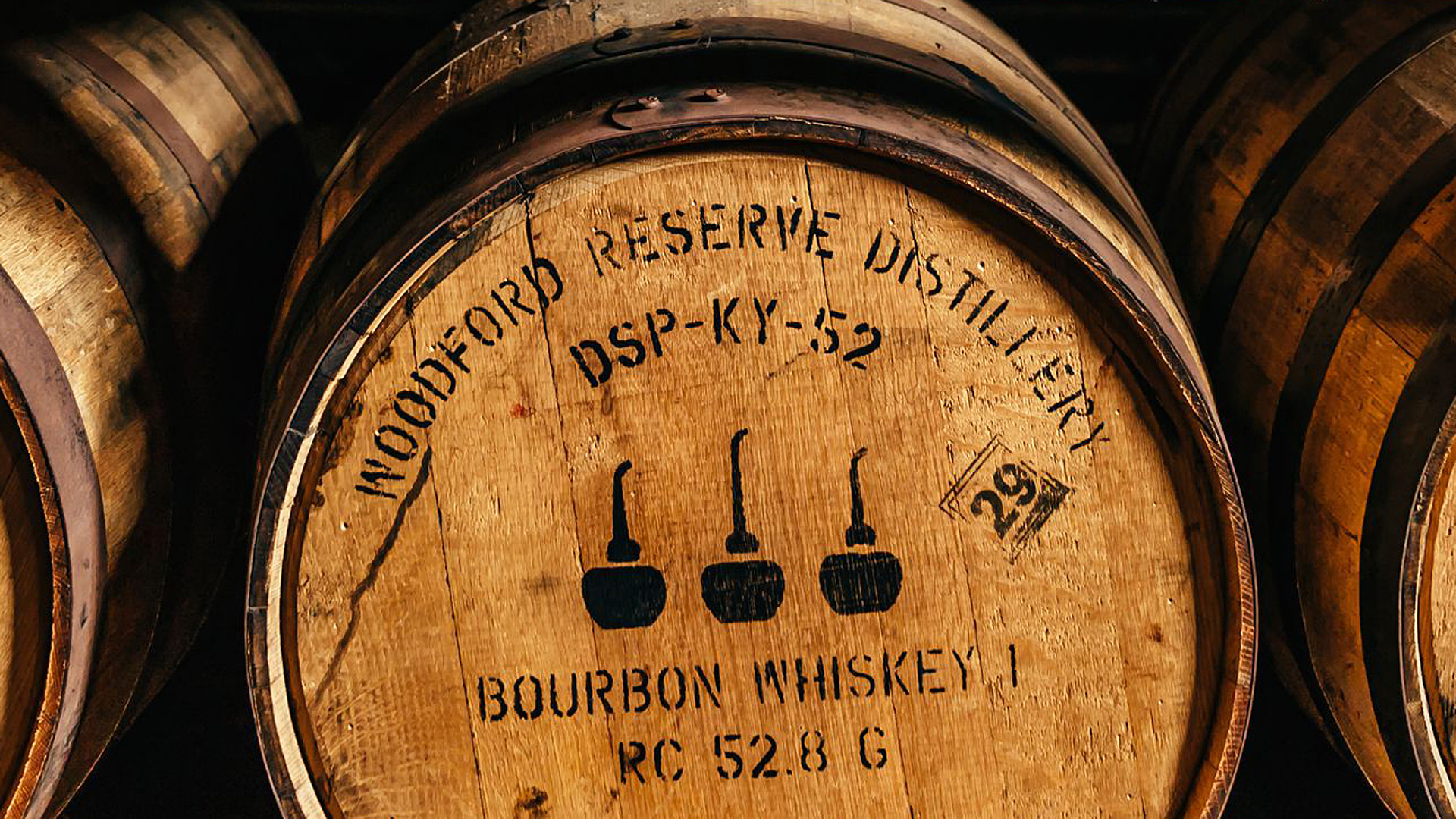
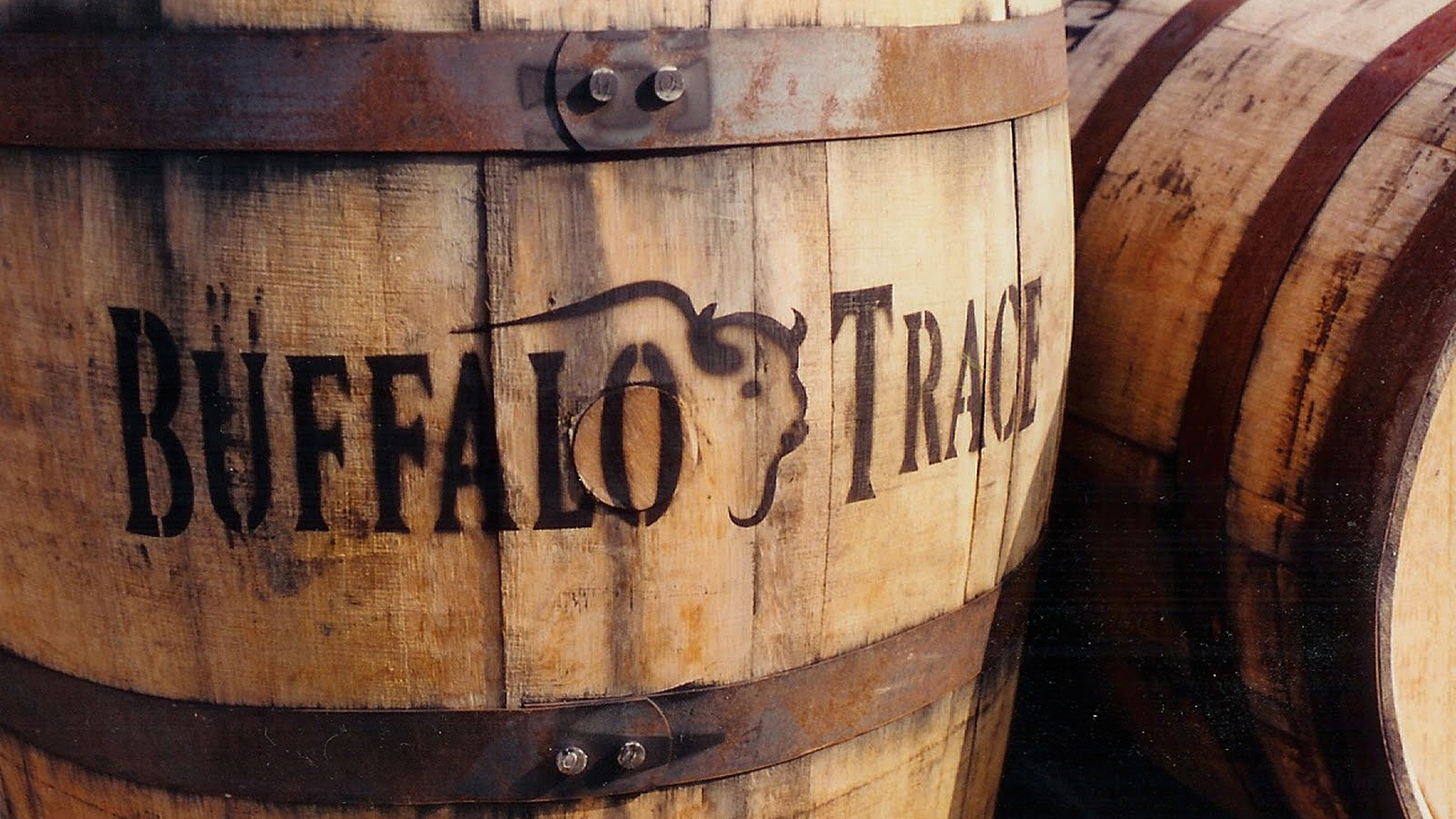
Each finished barrel is iron-branded with the appropriate logo and sanded one last time to remove any final scuff marks before being shipped. |
| Once the barrels are completed, they are filled with a clear high wine and closed with a bung and transported to the warehouse by truck and unloaded and placed on racks for storage of six years or more. |
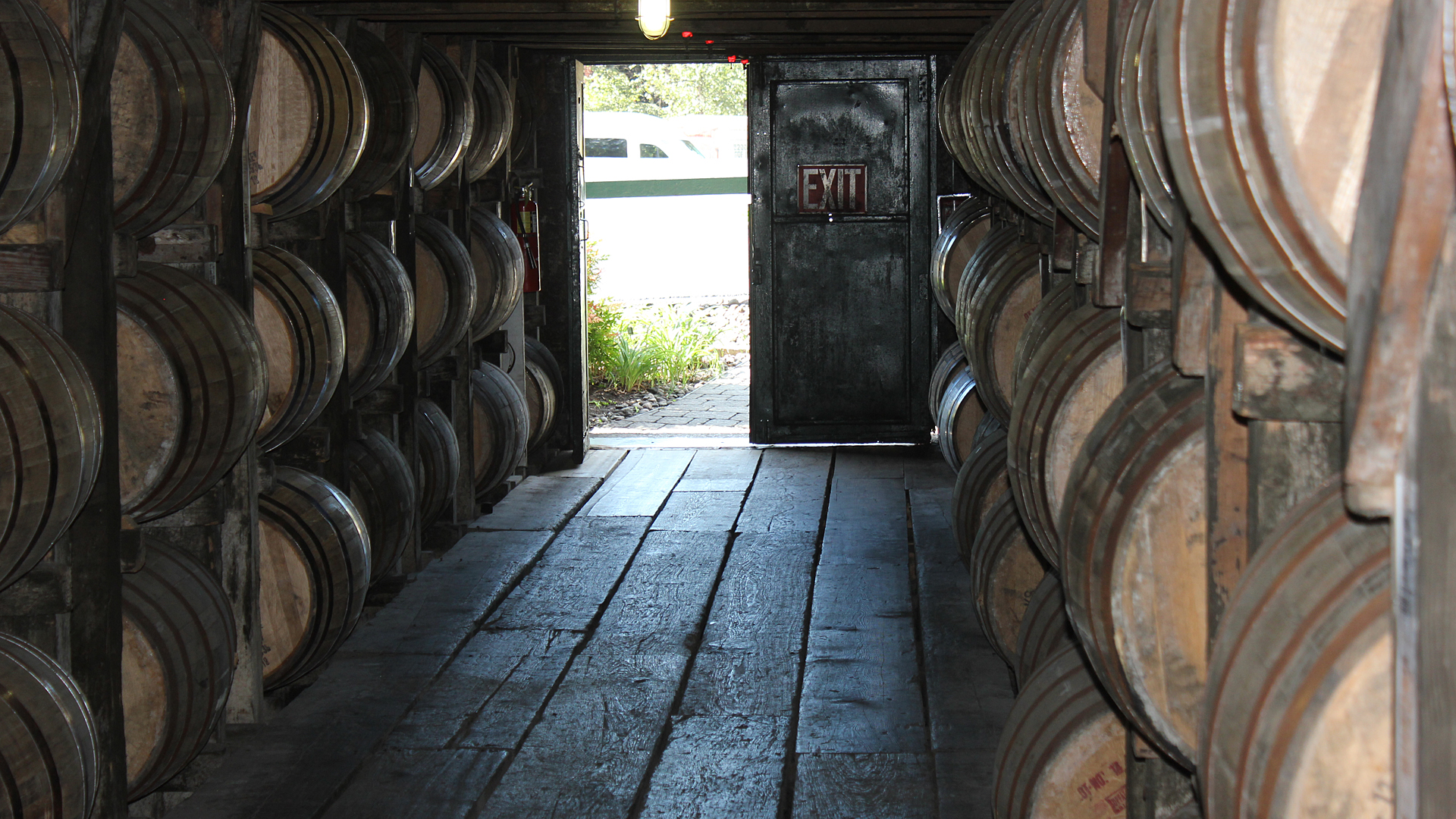
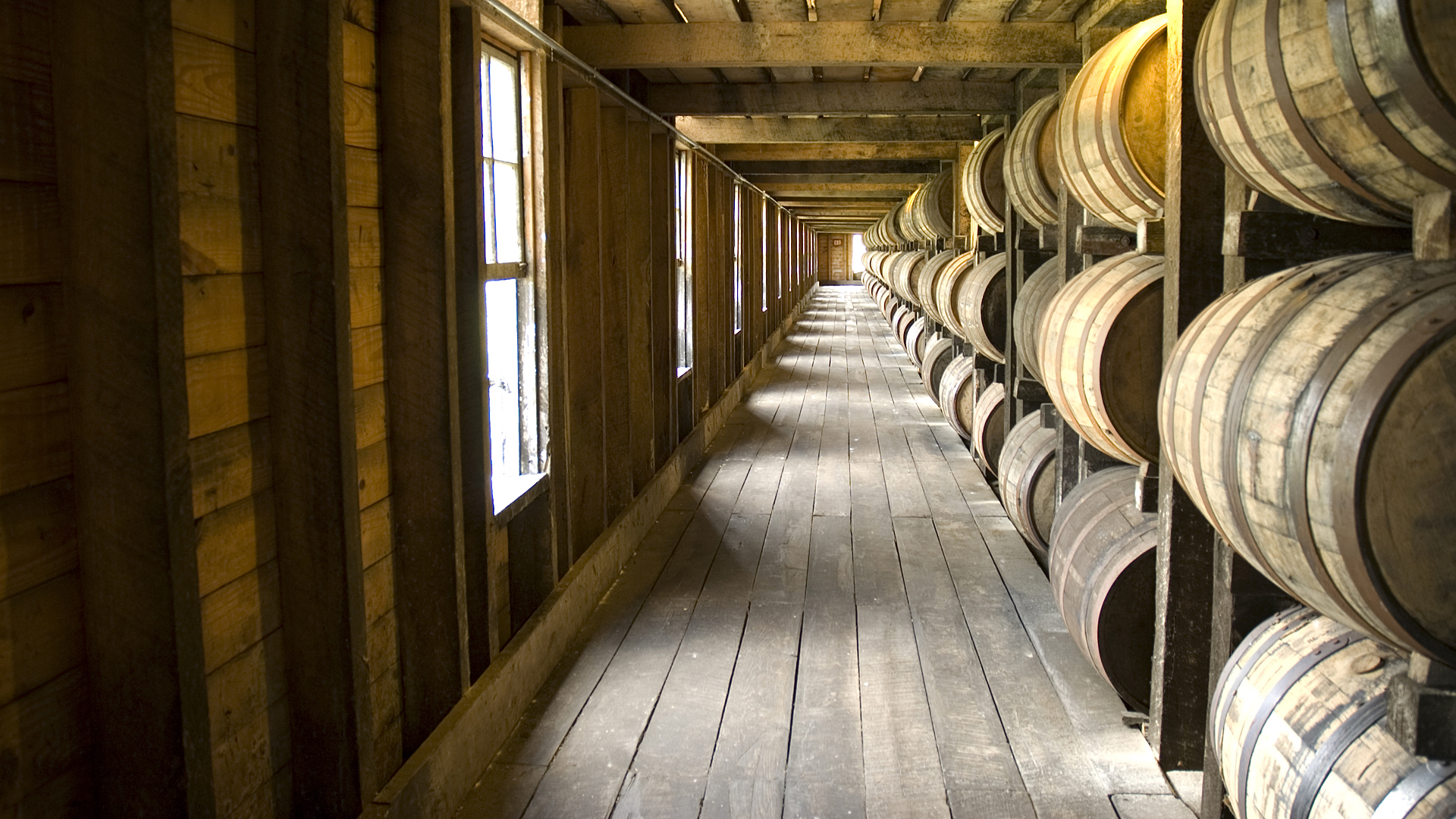 Each distillery has their own preferences for storing the barrels. In the past warehouses with a height of 4 to 5 floors were built. On each floor between 3 and 6 layers of barrels are stored. An ordinary warehouse has a capacity of approximately 20,000 barrels.
Each distillery has their own preferences for storing the barrels. In the past warehouses with a height of 4 to 5 floors were built. On each floor between 3 and 6 layers of barrels are stored. An ordinary warehouse has a capacity of approximately 20,000 barrels.
The warehouses have a skeleton of bars and girders that make it possible to roll the barrels horizontally. Between this skeleton there are elevators that make the vertical movement of the barrels possible.
In these warehouses a very special climate is created. Below the roof there are very high temperatures in the summer, while at the bottom it stays as cool as if the room was air-conditioned. For temperature equalization with the outside air a warehouse has many windows.
The whiskey matures differently on each floor. In the past the barrels were therefore rotated. Rotating means the barrels are moved to different pre-determined positions within the warehouse during maturation, so each barrel can profit from the good positions in the middle of the warehouse. However, a certain part of the warehouse (usually 1/3 of the total capacity) must stay empty for rotation. Maker's Mark was one of the few distilleries that still rotated their barrels in 2018.
The other distilleries have chosen a different way. They no longer rotate but mix barrels from different positions in the warehouse before bottling. With this method you avoid the labor intensive rotation of the barrels, you use up the whole capacity of the warehouse and you gain an area in the center of the warehouse where you find extraordinary barrels for small batch bourbons and single barrel bottlings.
There are basically four primary things that happen during storage: addition, subtraction, oxygenation, and reaction.
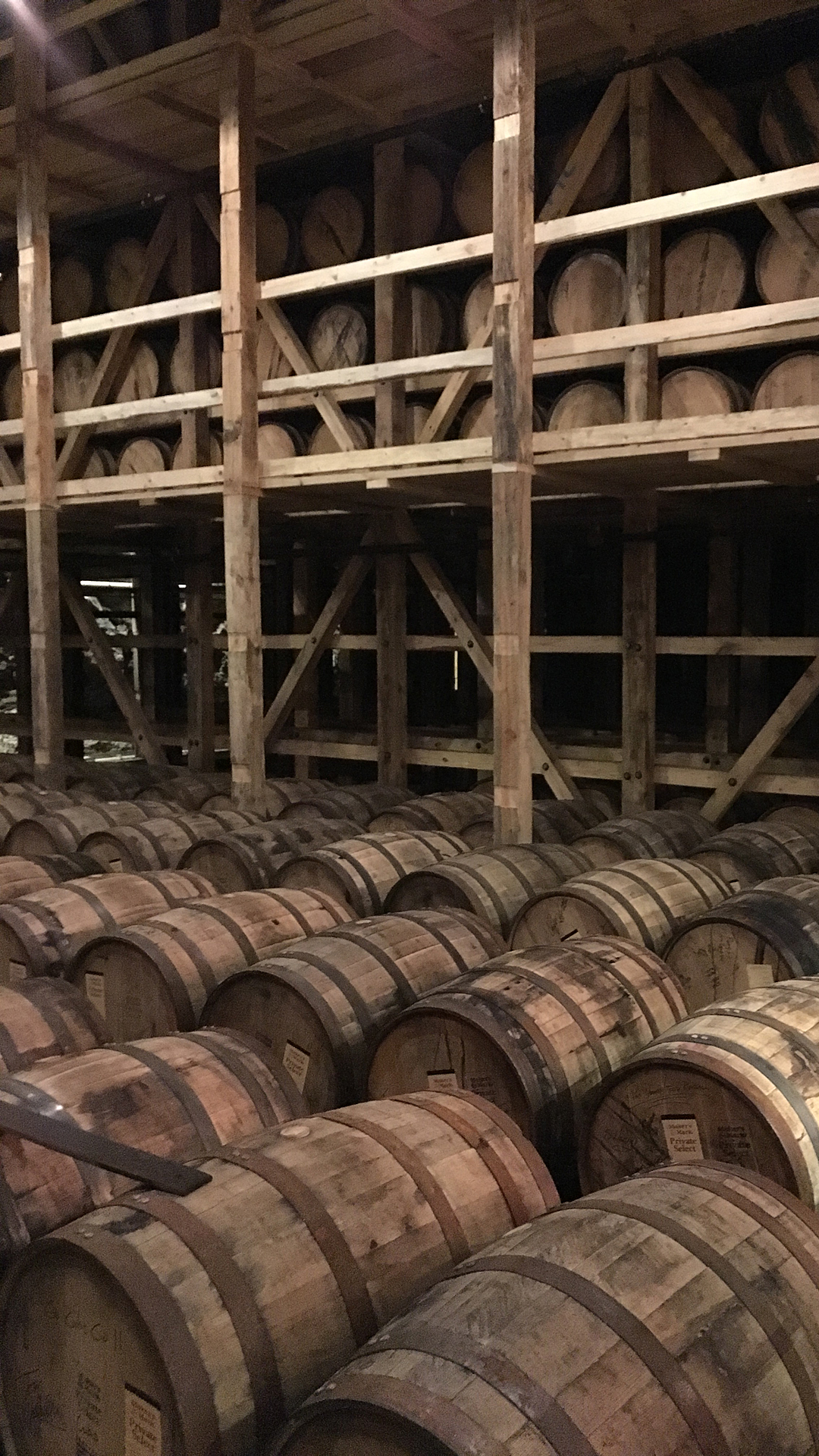 Different weather conditions cause different compounds to enter the whiskey. In 2006, a tornado ripped the roof off of Warehouse C at Buffalo Trace Distillery in Frankfort. As the damage was assessed and eventually repaired, dozens of barrels of bourbon sat at the top of the rickhouse completely exposed to the elements. A few years later it was bottled and labeled as "Tornado Surviving Bourbon," and there was something about it that people went wild for. This inspired Buffalo Trace to build Warehouse X, where they could conduct various experiments on the maturation process of bourbon that included controlled variants in temperature, light and more. There are five separate chambers with sensors that monitor the conditions day and night. After more than two years there has been only one phase of the study completed with 3.5 million data points collected. What it has proven is that you can change the environment (temperature, humidity, ventilation, etc.) and it will impact the bourbon's taste.
Different weather conditions cause different compounds to enter the whiskey. In 2006, a tornado ripped the roof off of Warehouse C at Buffalo Trace Distillery in Frankfort. As the damage was assessed and eventually repaired, dozens of barrels of bourbon sat at the top of the rickhouse completely exposed to the elements. A few years later it was bottled and labeled as "Tornado Surviving Bourbon," and there was something about it that people went wild for. This inspired Buffalo Trace to build Warehouse X, where they could conduct various experiments on the maturation process of bourbon that included controlled variants in temperature, light and more. There are five separate chambers with sensors that monitor the conditions day and night. After more than two years there has been only one phase of the study completed with 3.5 million data points collected. What it has proven is that you can change the environment (temperature, humidity, ventilation, etc.) and it will impact the bourbon's taste.
Tannins are another flavor compound that enters the whiskey in hotter temperatures. For this reason an extended hot summer or too many summers can have a detrimental effect on maturing bourbon. It's also why Maker's Mark built a man-made cave to age its Maker's Mark 46 line of products. The cellar is underground to maintain a cool temperature to age Maker's Mark 46 without releasing tannins into the content of the barrel and it allows for year round production.
Knowing that, it stands to reason that changes in weather patterns can have an impact on the end product that comes out of the barrel. The longer the bourbon is aged the impact of the exposure to the atmosphere is averaged out and the taste will be close to what is expected.
Every barrel of stored bourbon has an evaporation loss. It may be a little or it may be a lot but it does happen. A whiskey barrel could lose 30% to 40% of its volume between the original barreling and the time the liquid is ready for bottling.
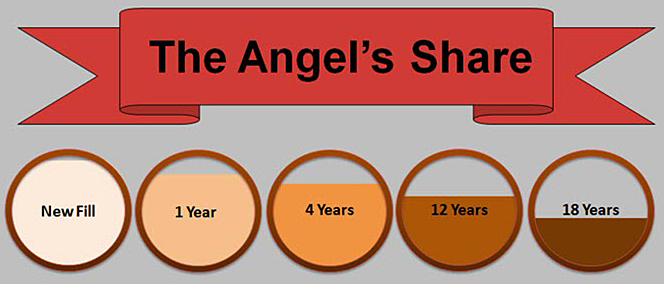 Wood is a porous material that expands and contracts with the seasons. Think about the house or apartment you live in. Do you have a door that occasionally sticks? When you stop to think about it, it doesn't stick all the time, it only sticks in the summer when the humidity tends to be higher. In the winter that same door works just fine. This same expansion and contraction happens with wooden barrels as their content matures inside.
Wood is a porous material that expands and contracts with the seasons. Think about the house or apartment you live in. Do you have a door that occasionally sticks? When you stop to think about it, it doesn't stick all the time, it only sticks in the summer when the humidity tends to be higher. In the winter that same door works just fine. This same expansion and contraction happens with wooden barrels as their content matures inside.
The amount the evaporation loss varies widely based on barrel size, time, environmental conditions and even the location in the warehouse.
The size of the barrel does make a difference. You might assume the larger the barrel the faster the evaporation rate. In fact, it's the opposite, the smaller the barrel the faster the evaporation rate because there's more liquid by volume in touch with the wood which is in touch with the air which draws the Angel's Share out of the barrel.
One year maturity in a warm and humid climate like Kentucky is completely different than one year in a milder climate like the Isle of Islay. Scottish distillers are allowed to write off 2% of their production volume each year to the Angel's Share. When it comes to Kentucky Bourbon or Rye or Tennessee whiskey their Angel's Share may average closer to 4% and could be as high as 10% in the first year. A good portion of that 10% number is actually absorbed into the staves of the barrel in year one. With Kentucky recording average summer highs of around 89 degrees F compared to 66 degrees F in Scotland, both the level of evaporation and rate of maturation are greatly accelerated. It's believed that if two exact barrels of liquid were placed in Scotland and Kentucky at the same time, the barrel in Scotland would have to remain there for around three years to equal just one year in Kentucky. This is a good example of not judging a whiskey merely by the age on its label. Maturity does not necessarily equal age.
The style of warehouse and the location in the warehouse also greatly affects the Angel's Share and many other characteristics of the final product. The atmosphere at the top of a rickhouse is very hot and dry, allowing the water molecules to escape much faster than the alcohol molecules thus driving the proof up in those barrels and concentrating the flavors inside the barrel. The atmosphere at the bottom of the rickhouse is moist and cool. Since a water molecule is very small, water can penetrate the barrel from the surrounding moisture and that drives the proof down to around 110 in those barrels.
There is no single answer to how much is lost each year. Other variables include the entry proof of your spirits into the barrel. Spirits barreled at 125 proof have a higher alcohol vs. water ratio than spirits barreled at say 103 proof. Low humidity and higher temperatures will draw more water through the staves resulting in higher alcohol content. And, higher humidity will result in more alcohol evaporating than water.
As your variables change, so will your results. The key is to keep good records and you'll continue to produce consistent distilled spirits. The same applies to your experiments, always keep good records so those results can be repeated.
You are never really going to know the Angel's Share vs. your share until that glorious day you pop the bung out of the barrel and start filling your bottles!
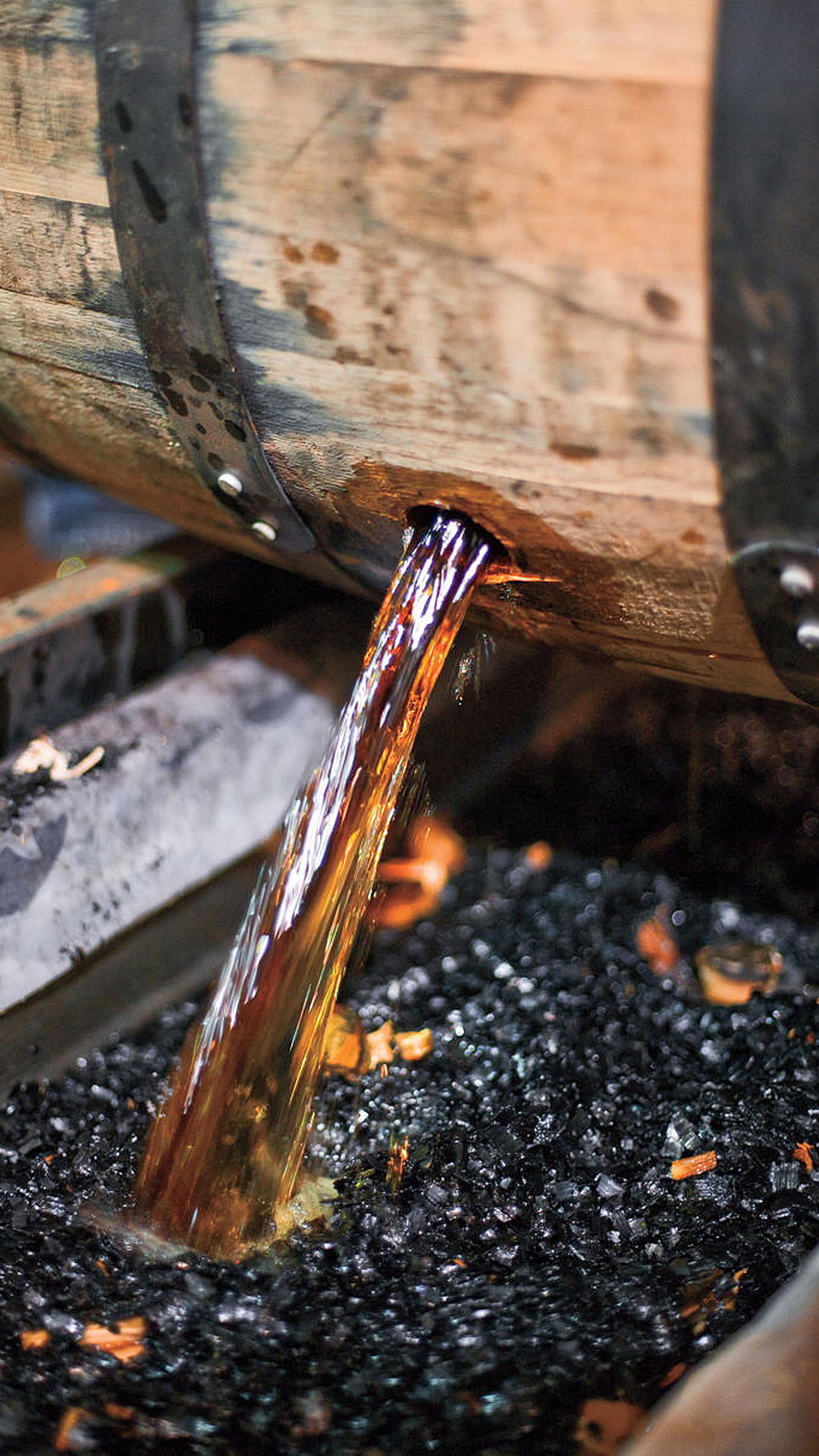
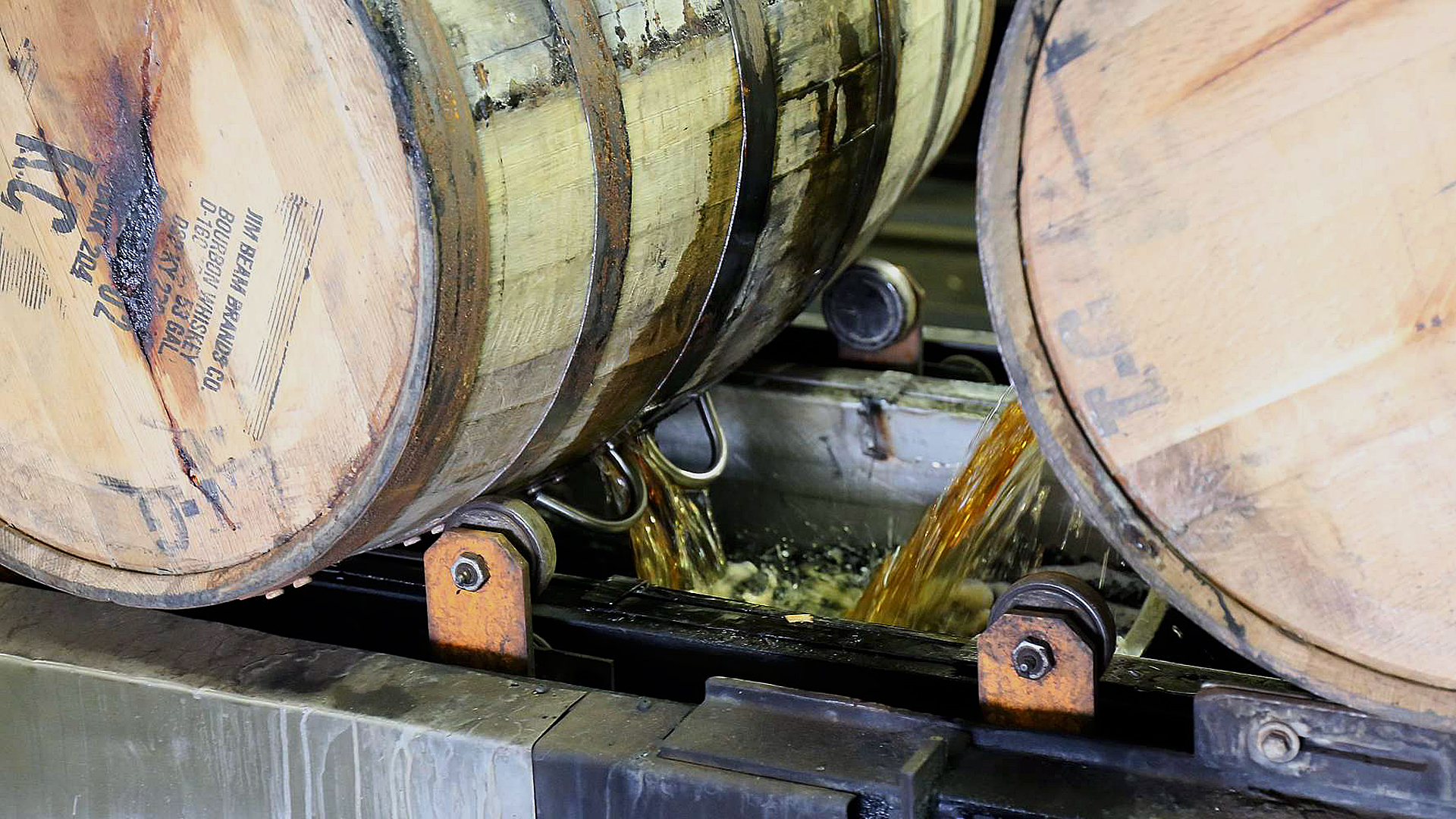
|
The Bourbon is pumped into a storage vat and from there fed to the bottling line. Bottles are filled, labeled and prepared for shipping.
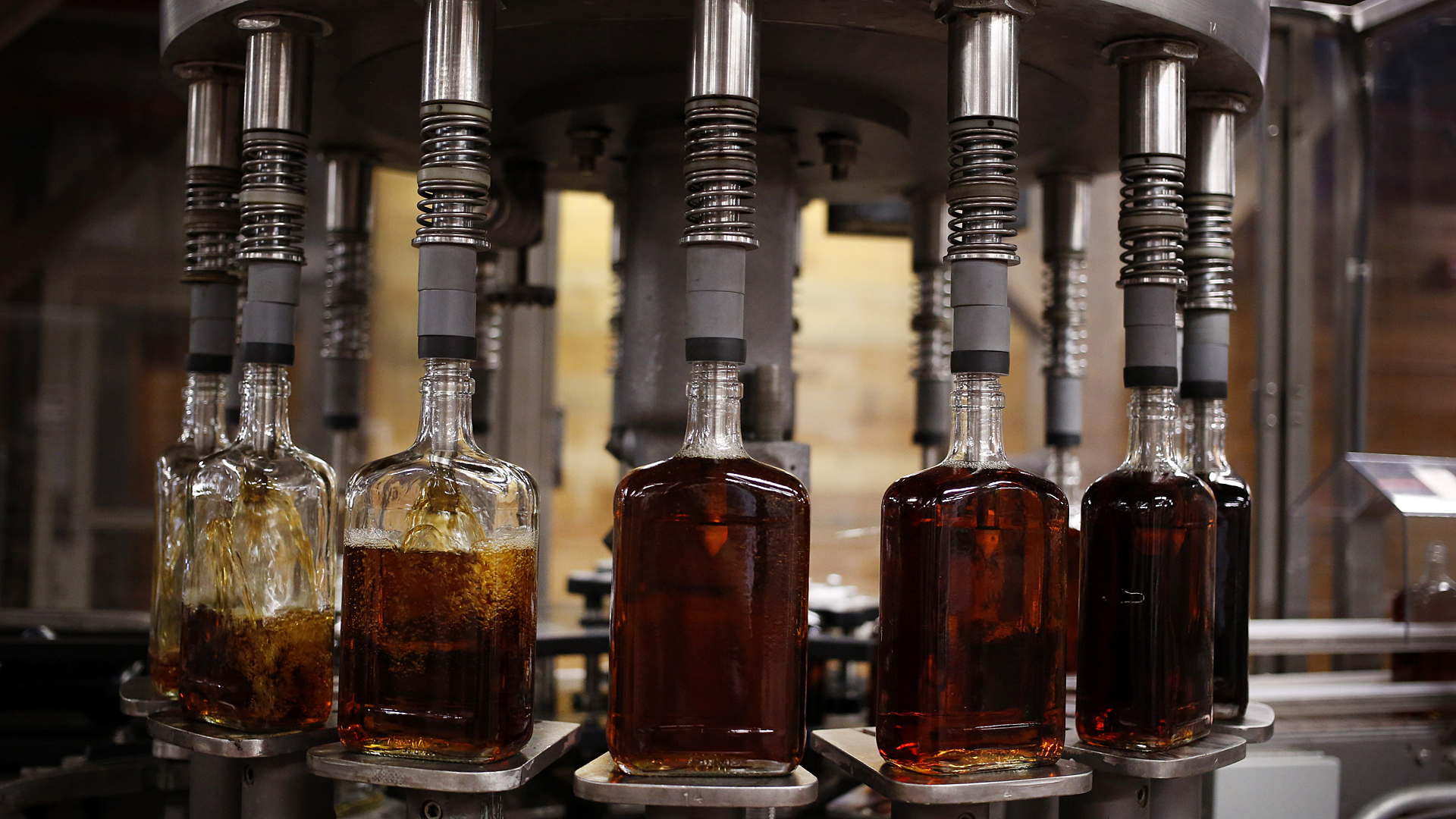
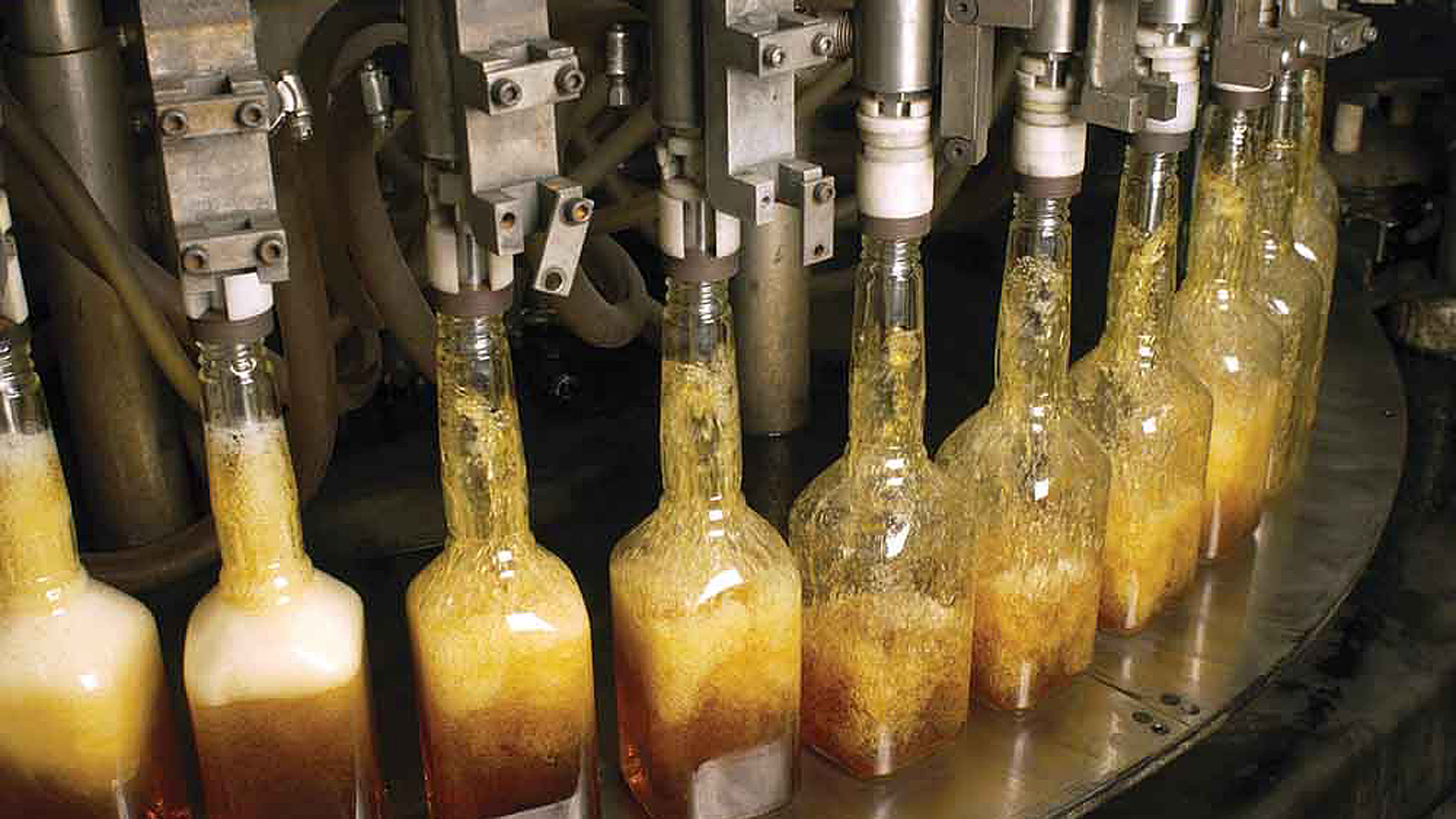
|
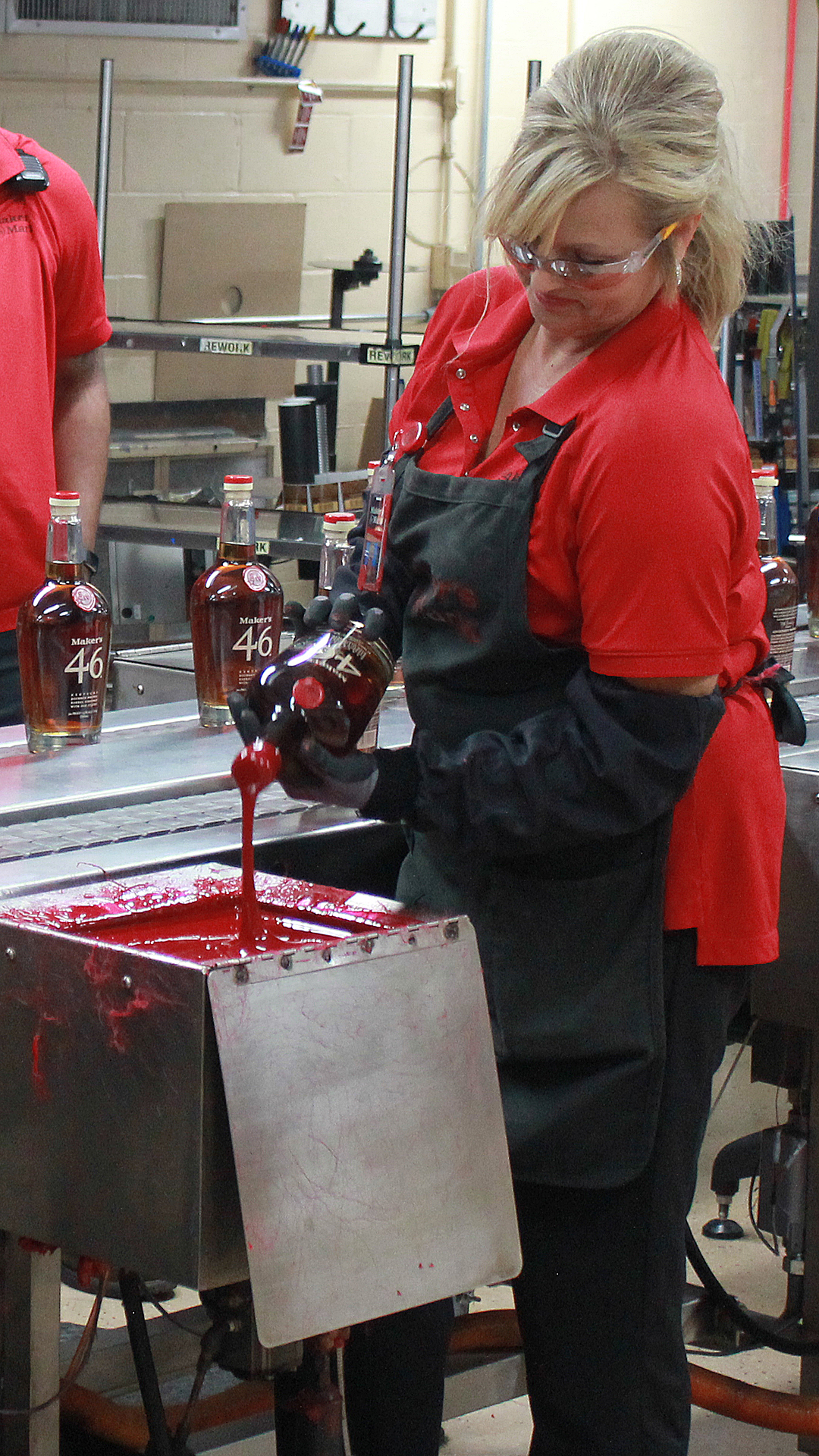
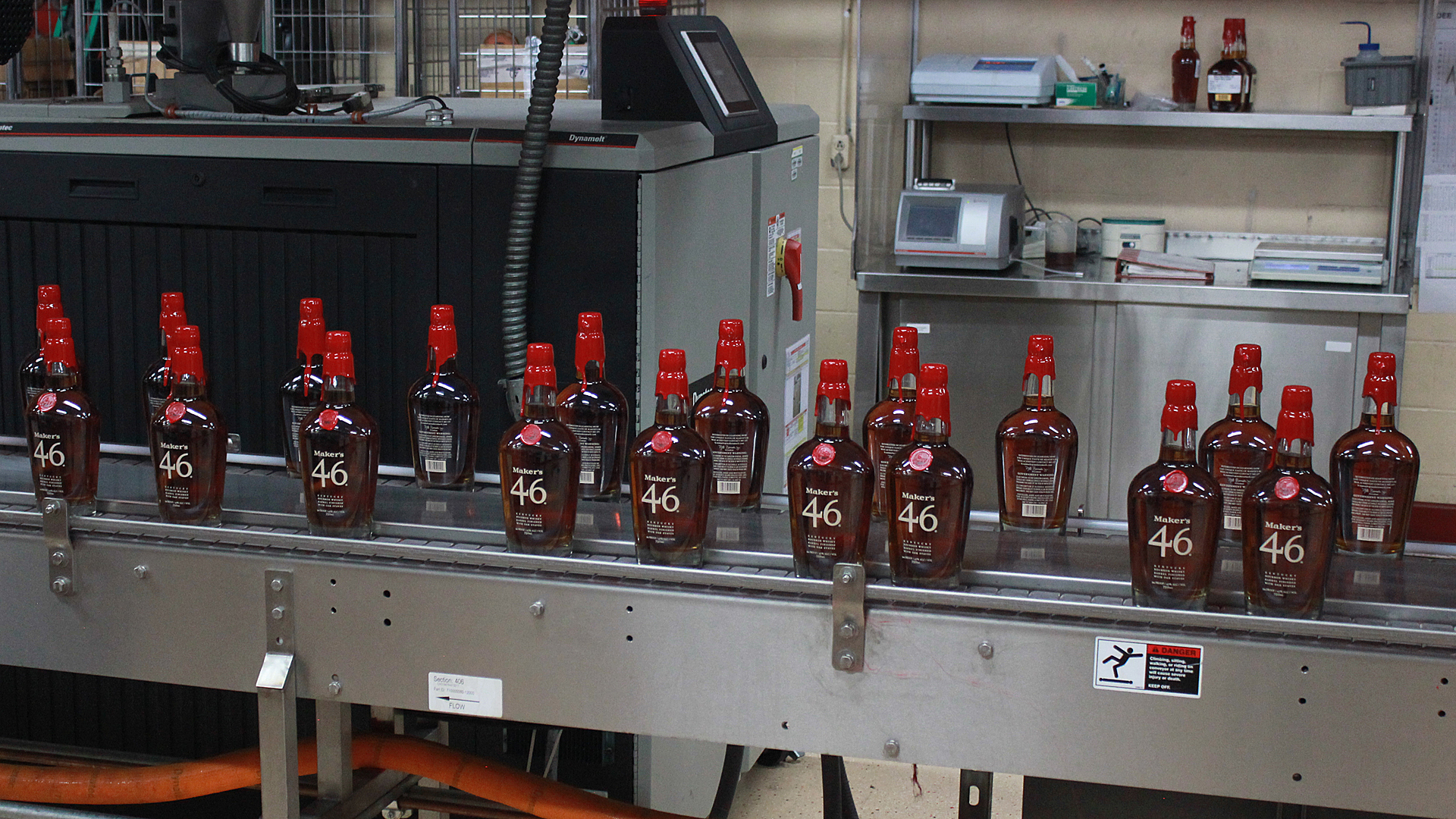
|
Backset: The thin, watery part of a previously distilled batch of whiskey mash that is added or "set back" into the next batch. Also "sour mash, setback, stillage or spent beer."
Barrel proof: Whiskey bottled at the desired proof while aging in the barrel. No water is added before bottling, so these Bourbons are higher proof than others.
Beer still: A giant apparatus in which the main component is a very tall metal column used to separate the alcohol from the water in the distiller's beer by vaporizing the alcohol content. Also called a "continuous still." The spirit produced is called "low wines."
Bourbon (straight): A whiskey made from a mash containing at least 51 percent corn, distilled out at a maximum of 160 proof, aged at no more than 125 proof for a minimum of two years in new charred oak barrels. If the whiskey is aged for less than four years, its age must be stated on the bottle. No coloring or flavoring may be added to any straight whiskey.
Bung: The stopper used to seal a barrel.
Charring: The process that sets fire to the interior of barrels for less than one minute and creates a layer of charred wood. Distillers can choose from four levels of char.
Corn whiskey: A whiskey made from a mash containing a minimum of 80 percent corn and, if it is aged at all, must be aged in used or uncharred oak barrels.
Distiller's beer: The thick, fermented mash of cooked grains, water and yeast that is transferred from the fermenter to the beer still for the first distillation.
Doubler: A large copper still used to accomplish the second distillation of American whiskey. It effectively removes impurities and concentrates the alcohol even further. "Low wines" go in; "high wines" come out.
Fermentation: The process by which yeast transforms sugar into alcohol and carbon dioxide.
Fermenter: A giant tub made of metal or cypress in which the mash of cooked grains and water meet the yeast. They mingle, the yeast begins to act on sugars in the grain, and fermentation occurs over a few days. This produces alcohol within the mash and turns it into distiller's beer.
Heads: The first section of the high wines to exit the doubler or thumper; this spirit is high in impurities and sent back to the still for redistillation.
High wines: The final spirit produced by the secondary distillation, ready for aging.
Low wines: The name of the spirit after it has passed through the beer or continuous still for its first distillation.
Malted barley: Barley that has been partially germinated and then heated or roasted to stop the germination. Malted barley (or any malted grain) contains enzymes that convert starches into the fermentable sugars on which yeast feeds. These enzymes are not present in unmalted grains.
Mash: The mixture of cooked grains and water before the yeast is added to start fermentation.
Mashbill: The grain recipe used to make whiskey.
Mash tub: A large tub where the grains are combined with water and cooked to soften them and break down the starch into simple sugars before the resulting "mash" is transferred to the fermenter. Also called a "cooker."
Nose: The aroma of a whiskey.
Proof: Measurement of beverage alcohol on a scale, in America, of 200. A 100 proof spirit contains 50 percent alcohol.
Rackhouse/Rickhouse: The building in which whiskey is aged, sometimes referred to as the "warehouse."Ricks: The wooden structures on which barrels of whiskey rest during aging.
Rye whiskey (straight): A whiskey made from a mash containing at least 51 percent rye, distilled out at a maximum of 160 proof, aged at no more than 125 proof for a minimum of two years in new charred oak barrels. If the whiskey is aged for less than four years, its age must be stated on the bottle. No coloring or flavoring may be added to any straight whiskey.
Single barrel whiskey: Whiskey drawn from one barrel that has not been mingled with any other whiskeys.
Small batch whiskey: A product of mingling select barrels of whiskey that have matured into a specific style.
Tails: The last section of high wines to exit the doubler or thumper; this spirit is high in impurities and sent back to the still for redistillation.
Thief: A tubular instrument for removing a sample from a barrel.
Thumper: One of the types of stills used to accomplish the second distillation of American whiskey. It effectively removes impurities and concentrates the alcohol even further. "Low wines" go in; "high wines" come out. Thumpers differ from doublers in that the low wines enter a thumper as vapors that are bubbled through water, causing the stills to make a thumping sound; a doubler makes no distinctive noise since the low wines enter in condensed, liquid form.
Wheated bourbon: Bourbon made from a mashbill that contains wheat instead of rye grain.
Yeast: A living organism that feeds on fermentable sugars, transforming them to beverage alcohol, congeners, carbon dioxide, and heat.